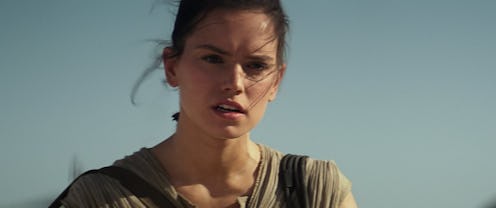Entertainment
How Feminist Are The 'Star Wars' Women's Costumes?
An audible cheer went up across the Internet when Disney decided to retire Princess Leia's infamous gold bikini. It's not the only thing that Carrie Fisher wears in the original Star Wars trilogy, but it's certainly the most visible, spawning Halloween costumes and figurines and lingering in the collective pop culture memory far more than the draped, toga-inspired garb she wears nearly every other scene. So gone is the bikini, and in its place is not only a newly empowered General Leia, but also Star Wars' newest heroine Rey, played by newcomer Daisy Ridley. Both of these might be considered a step forward, but are more utilitarian costumes for Rey and Leia really a win for feminism?
The real problem with the gold bikini is that it has come to stand in for Fisher's, and Leia's, objectification in the film. In the movie, Princess Leia seizes control of her own captivity, slaying her captor without needing a chivalrous dude to swoop in and save the day. Yet the costume has remained the lasting symbol of Leia's legacy. In an October interview between Fisher and Ridley, Fisher asserted that her character was not a sex symbol, and advised Ridley, "You should fight for your outfit. Don't be a slave like I was." But though the gold bikini — known as the "Slave Leia" outfit — remains the best-known costume among women in Star Wars, it was a small part of a series that has actually empowered its female characters (though their numbers have been few), from Leia to Natalie Portman's Padme Amidala to Ridley's Rey.
Costumes aside, Padme and Leia share a penchant for fireworks and skill with a weapon. In 1983, Fisher told Rolling Stone that, though the filmmakers had tried to empower Leia, "The only way they knew to make the character strong was to make her angry. In Return of the Jedi, she gets to be more feminine, more supportive, more affectionate. But let's not forget that these movies are basically boys' fantasies. So the other way they made her more female in this one was to have her take off her clothes." And thus the bikini is born.
But it's not just the bikini — many of both Leia and Padme's early costumes were bulky and constrictive. Circle skirts and headdresses are not conducive to swordplay, or lightsaber-play, though both women still took down more than a few stormtroopers in their time. The truly empowering aspect of women's costumes in The Force Awakens is that the freer clothing allows them to fulfill their duties as footsoldiers and fighters. They take care of themselves, and they dress for the task.
In The Force Awakens, Leia both transcends the costume and her own title, moving from Princess to General Leia. And she takes a supporting role to Ridley's Rey, the strong, totally badass woman at the fore of The Force Awakens. From what we've seen of Rey's attire so far, it's more pragmatic than the flowing skirts of the first six films, allowing her to jet around on a Mad Max-looking hoverbike and battle enemies with a lightsaber inherited from Han Solo. Of her character, Ridley told Elle, "She's cool and smart and she can look after herself. Young girls can look at her and know that they can wear trousers if they want to."
That might be the most important legacy of the new costumes: Ridley's loose pants are more functional than aesthetic, and they force observers to reckon with her skill as an actress and her character's assets aside from her looks. It's not on women to cover up in order to be taken seriously in film and in life. It's on the observer to consider the woman as something more than a sex-object in spite of her wardrobe choices. Yet the costumes of The Force Awakens recognize an empowering reality: that women choose to dress for their circumstances, and that they are more likely to select pants than skirts for a high-speed chase through the desert — costumes that highlight swordsmanship over a woman's ability to run in heels.
For more Star Wars, check out Bustle's Youtube channel:
Image: Walt Disney Studios (3)
